Phnom Penh, the vibrant capital city of Cambodia, is a place where the past casts a long shadow. Like a haunting melody, the echoes of a dark and painful history can still be heard.
In this article, we explore the depths of the infamous Killing Fields and the Tuol Sleng Genocide Museum. A four-hour tour offers a chance to take in the tragic events that unfolded during the Khmer Rouge Regime from 1975 to 1979. Led by knowledgeable guides, visitors pay respects at the site where over one million lives were lost.
The journey also takes them to the Genocide Museum, where relics from that time are displayed. This article sheds light on the atrocities committed and serves as a comprehensive guide for those seeking to understand and remember the lives lost.
Good To Know
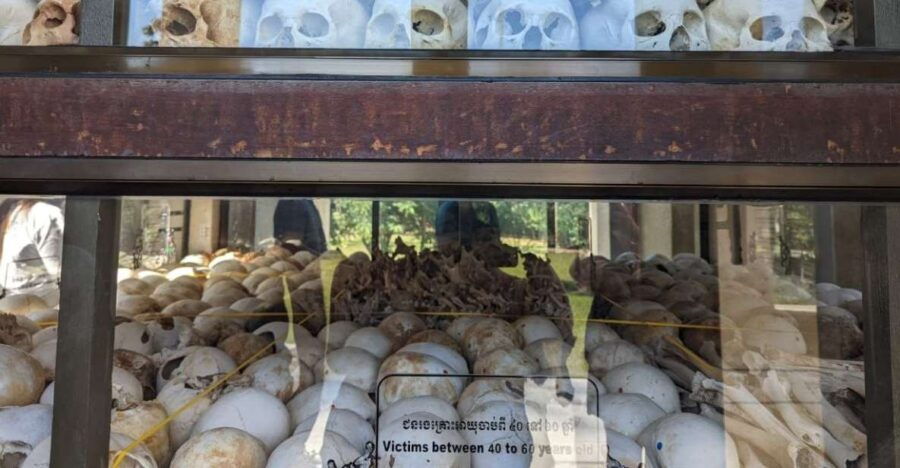
- The activity offers free cancellation up to 24 hours in advance for a full refund.
- The duration of the activity is 4 hours and it is recommended to check availability for starting times.
- The tour includes visits to the Killing Fields and the Genocide Museum to learn about the dark history of Cambodia during the Khmer Rouge Regime.
- Participants will have the opportunity to ask questions and learn about the atrocities committed during that time period.
Dark History of Cambodia
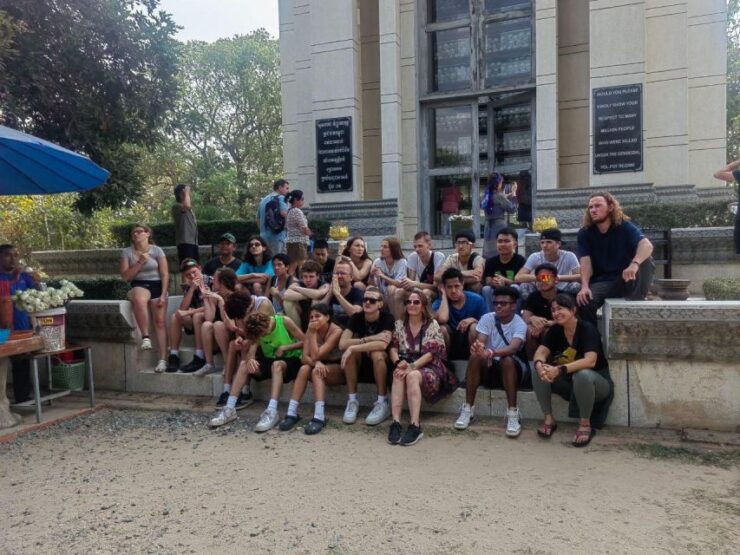
During the Khmer Rouge Regime, Cambodia experienced a dark history marked by atrocities and mass killings. This period, spanning from 1975 to 1979, left a deep scar on the nation and its people.
It’s important to remember the victims and acknowledge Cambodia’s dark past. The Khmer Rouge, led by Pol Pot, implemented radical policies that resulted in the deaths of over 1 million people. The regime sought to create an agrarian society and eliminate perceived threats to their ideology, targeting intellectuals, professionals, and even their own party members.
The Killing Fields and the Tuol Sleng Genocide Museum, also known as S-21, serve as stark reminders of the horrific acts committed during this time. Visiting these sites allows one to gain insight into the magnitude of the atrocities and pay homage to the innocent lives lost.
Cambodia continues to heal and rebuild, but remembering the victims is crucial in ensuring that such a dark chapter is never repeated.
Like museums? Other Phnom Penh cultural attractions we've reviewed
Tragic Sites and Guided Tour
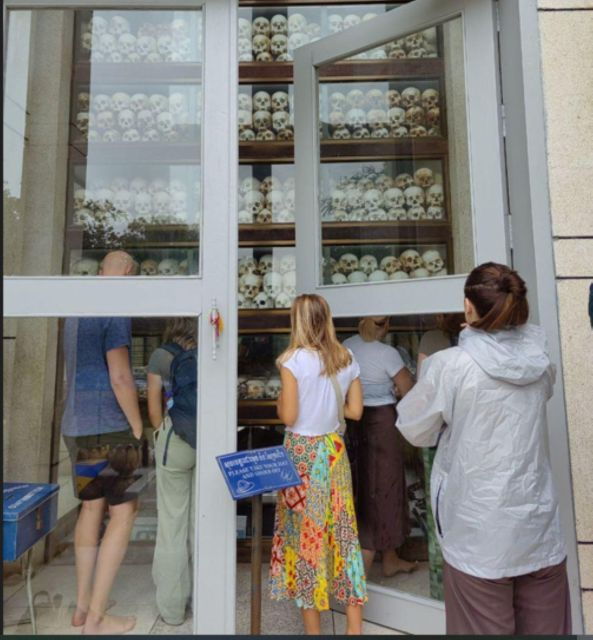
Visitors can explore the tragic sites of the Killing Fields and the Tuol Sleng Genocide Museum on a guided tour that provides a harrowing glimpse into Cambodia’s dark history. This tour offers a unique opportunity to learn about the atrocities committed during the Khmer Rouge Regime from knowledgeable guides who provide in-depth presentations.
Here are three reasons why this guided tour is a must-visit:
Deep Dive into Cambodia’s Dark Past: The tour allows visitors to explore the dark history of Cambodia, providing a comprehensive understanding of the Khmer Rouge Regime and the immense suffering endured by its victims.
Insightful Guided Presentations: Knowledgeable guides share their expertise, offering engaging presentations that shed light on the events that unfolded at these tragic sites. Visitors can ask questions and gain a deeper understanding of the Khmer Rouge period.
Immersive Experience: The guided tour provides an immersive experience, allowing visitors to pay their respects at the site where over one million people lost their lives. Seeing the bones and clothing rags left by the victims at the Killing Fields serves as a poignant reminder of the horrors that occurred.
Embarking on this guided tour promises a thought-provoking and emotionally charged experience, ensuring that the tragic sites of the Killing Fields and the Tuol Sleng Genocide Museum aren’t forgotten.
The Killing Fields: Over 1 Million Lives Lost
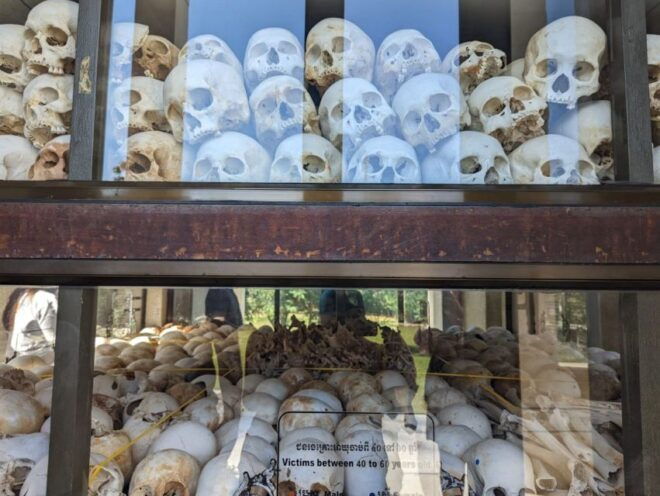
The Killing Fields claimed the lives of over one million people during the Khmer Rouge Regime. This dark period in Cambodian history, from 1975 to 1979, left a profound impact on the country and its people. To understand the magnitude of this tragedy, let’s take a closer look at the numbers:
| Over 1 million | Lives lost | |
| 4 years | Duration of regime | |
| 1975 – 1979 | Khmer Rouge Regime |
The impact of the Khmer Rouge on modern Cambodia cannot be overstated. The country went through a long and painful healing process, as it grappled with the trauma and devastation caused by the regime. The scars of this period can still be seen today, but Cambodia has made significant strides towards rebuilding and moving forward. It is crucial to visit sites like the Killing Fields and the Genocide Museum to pay respect to the victims and to gain a deeper understanding of Cambodia’s history. By acknowledging the past, Cambodia can continue to heal and grow into a brighter future.
The Genocide Museum: Relics From the Regime
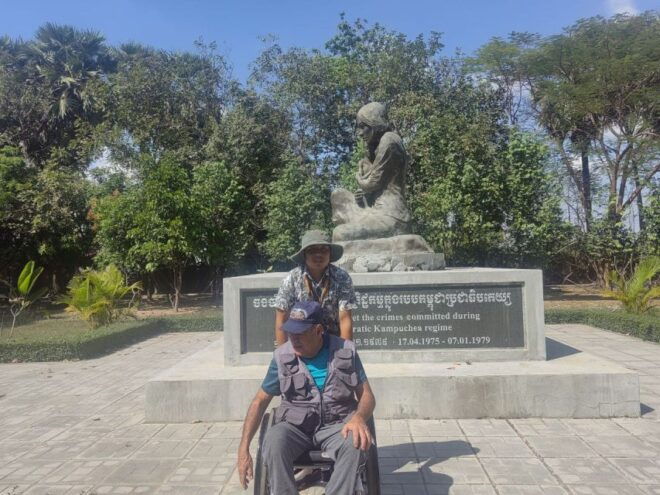
The Genocide Museum houses a collection of relics from the Khmer Rouge Regime, offering visitors a glimpse into the atrocities committed during that time. Here are three reasons why exploring these historical artifacts is a must:
Uncovering the truth: The museum provides a haunting insight into the Khmer Rouge atrocities, allowing visitors to understand the magnitude of the suffering endured by the Cambodian people.
Personal connection: The relics, such as photographs, clothing, and tools, humanize the victims and make their stories more relatable, evoking a deep emotional response.
Learning from history: By examining these artifacts, visitors can reflect on the consequences of unchecked power and the importance of preserving human rights, promoting empathy, and preventing similar atrocities from occurring in the future.
Visiting the Genocide Museum is a sobering experience that encourages reflection and serves as a reminder of the immense human tragedy that unfolded during the Khmer Rouge regime.
More Great Tours NearbyPol Pot and the Khmer Rouge Regime
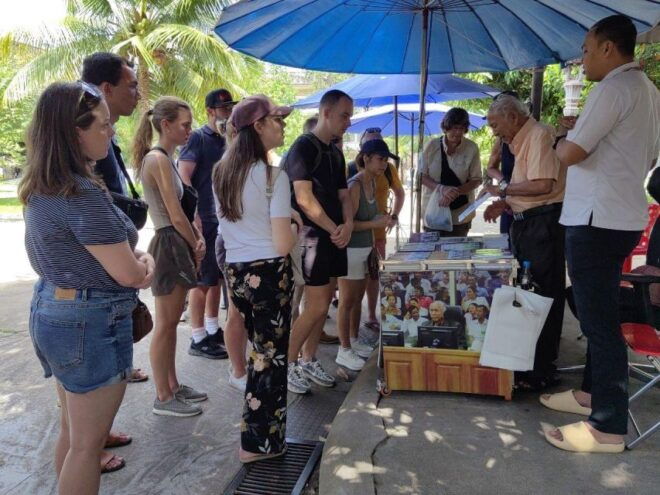
Continuing the exploration of the dark history of the Khmer Rouge Regime, one can explore the role of Pol Pot and his brutal regime in Cambodia’s tragic past.
Under Pol Pot’s leadership, the Khmer Rouge committed unimaginable atrocities that left a lasting scar on the nation. From 1975 to 1979, the regime implemented radical policies that aimed to create an agrarian utopia by forcibly relocating millions of people to rural areas and purging perceived enemies of the state.
The result was a devastating genocide, with over 1 million people losing their lives. Pol Pot’s regime was marked by extreme brutality, with widespread torture, mass executions, and forced labor.
The Khmer Rouge’s reign of terror has left a profound impact on Cambodia, and understanding Pol Pot’s leadership and the Khmer Rouge atrocities is crucial in comprehending the country’s tragic history.
Bones and Remnants at the Killing Fields
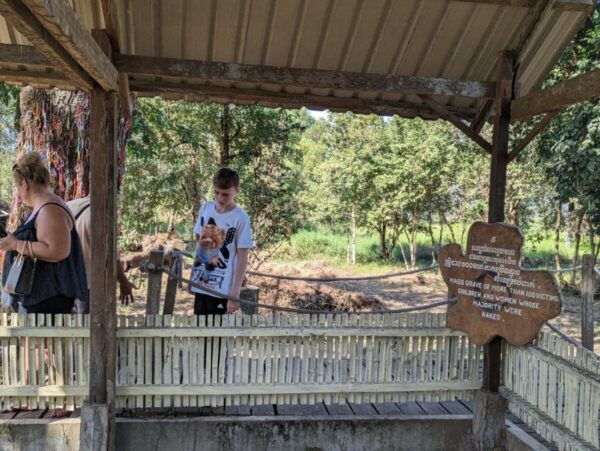
During the Khmer Rouge Regime, the Killing Fields witnessed the tragic loss of over 1 million lives, leaving behind a haunting sight of bones and remnants as a grim reminder of the atrocities committed.
The bones and remnants found at the Killing Fields hold immense historical significance and serve as a chilling testament to the brutality of this dark period in Cambodia’s history. Here are three reasons why they captivate visitors:
Bones Preservation: The bones at the Killing Fields have been preserved and arranged in memorial structures, giving visitors a visual representation of the scale of the genocide. The remains are a somber reminder of the lives lost and a stark contrast to the surrounding peaceful countryside.
Historical Significance: These bones and remnants stand as silent witnesses to the horrors endured by the victims. They serve as physical evidence of the genocide, allowing visitors to connect with the past on a deeply emotional level and understand the magnitude of the tragedy.
Personal Reflection: The presence of bones and remnants at the Killing Fields invites visitors to reflect on the immense loss and pay their respects to the victims. It creates a somber and contemplative atmosphere, encouraging visitors to learn from the past and advocate for peace and human rights.
Visiting the Killing Fields and witnessing these bones and remnants is a powerful and sobering experience, reminding us of the importance of remembering and learning from history to ensure that such atrocities are never repeated.
Common Questions
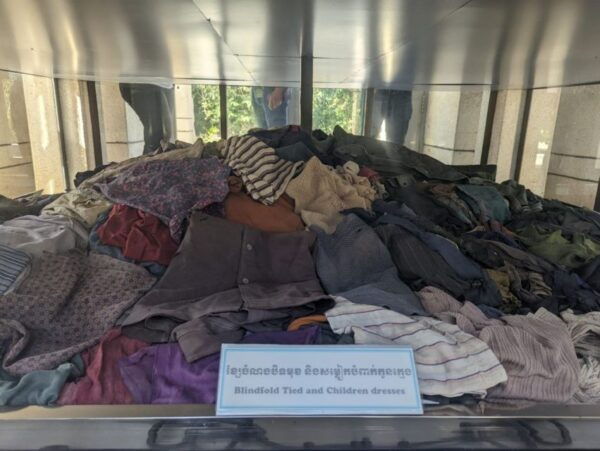
How Can I Cancel My Reservation for the Phnom Penh: the Killing Fields & Tuol Sleng Genocide Museum Tour?
To cancel a reservation for the Phnom Penh: The Killing Fields & Tuol Sleng Genocide Museum tour, visitors can follow the cancellation process and take advantage of the free cancellation policy for a full refund.
What Is the Duration of the Phnom Penh: the Killing Fields & Tuol Sleng Genocide Museum Tour?
The duration of the Phnom Penh: The Killing Fields & Tuol Sleng Genocide Museum tour is 4 hours. Recommended tour packages include the Killing Fields and Prison S21 Tour, the Day trip to visit 11 places in the City included S21 & Killing Field, the Private tour of S-21 Prison and Killing Fields, and the Guided tour of Phnom Penh’s Killing Fields.
Is There a Specific Starting Time for the Phnom Penh: the Killing Fields & Tuol Sleng Genocide Museum Tour?
The tour has a specific starting time and lasts for a certain duration. Visitors can find out the exact starting time and duration by checking the availability of the tour before making a reservation.
Can I Pay for the Tour Later or Do I Have to Pay Upfront?
Yes, travelers have the option to pay for the tour later. They can reserve their spot and pay nothing today, allowing them to keep their travel plans flexible.
Are There Any Other Related Tours or Experiences in Phnom Penh That Focus on the Khmer Rouge Regime?
Yes, there are other related tours and experiences in Phnom Penh that focus on the Khmer Rouge regime. These include visits to additional Khmer Rouge historical sites in the city, offering a deeper understanding of the impact on modern-day Cambodia.
The Sum Up
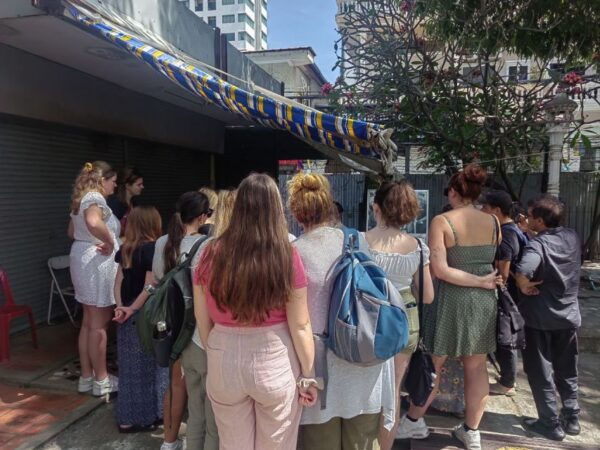
To sum it up, a visit to the Killing Fields and Tuol Sleng Genocide Museum in Phnom Penh is a haunting and eye-opening experience that allows visitors to explore the tragic history of Cambodia.
Led by knowledgeable guides, participants have the opportunity to pay respects at the site where over one million lives were lost and explore the museum’s chilling relics.
This tour serves as a powerful reminder of the atrocities committed during the Khmer Rouge Regime and the importance of remembering the lives lost.
You can check availability for your dates here: More Great Tours NearbyMore Museum Tours in Phnom Penh
- Private Killing Field Tour to Toul Sleng Genocide Museum
- Phnom Penh: The Killing Fields, Toul Sleng and Genocide Museum
- Private Half Day Trip to Genocidal Museum & Killing Field
- Killing Fields & Toul Sleng Genocide Museum Tickets With Tuk Tuk
- Half Day Tour Genocide Museum and Killing Field
- The Killing Field and Toul Sleng Genocide Museum (S21) Tour
More Tour Reviews in Phnom Penh
Looking for something different? Other Phnom Penh activities we've written about
- 6 Best Shopping Tours In Phnom Penh
- 10 Best Massage And Relaxation Services In Phnom Penh
- 3 Best Motorbike And Scooter Rentals In Phnom Penh
- 25 Best Tours In Phnom Penh
- 2 Best Workshops And Classes In Phnom Penh
- 12 Best 3 Day Tours In Phnom Penh
- 23 Best Boat Tours And Cruises In Phnom Penh
- 6 Best 4 Day Tours In Phnom Penh
- 14 Best Full-Day Tours In Phnom Penh
- 20 Best Private Driver Services In Phnom Penh
- 18 Best Guided Tours In Phnom Penh
- 2 Best 3 Hour Tours and Experiences in Phnom Penh
